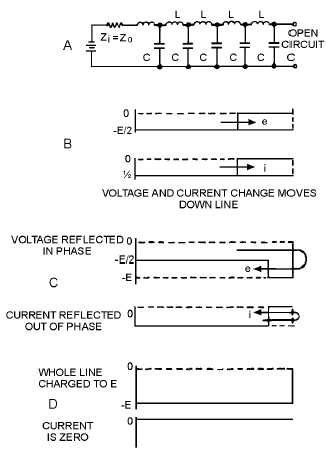3-29
Figure 3-24.—Reflection from an open-ended line.
When the battery is connected to the sending end as shown, a negative voltage moves down the line.
This voltage charges each capacitor, in turn, through the preceding inductor. Since Zi equals Z
0, one-half
the applied voltage will appear across the internal battery impedance, Zi, and one-half across the
impedance of the line, Z0. Each capacitor is then charged to E/2 (view B). When the last capacitor in the
line is charged, there is no voltage across the last inductor and current flow through the last inductor
stops. With no current flow to maintain it, the magnetic field in the last inductor collapses and forces
current to continue to flow in the same direction into the last capacitor. Because the direction of current
has not changed, the capacitor charges in the same direction, thereby increasing the charge in the
capacitor. Since the energy in the magnetic field equals the energy in the capacitor, the energy transfer to
the capacitor doubles the voltage across the capacitor. The last capacitor is now charged to E volts and the
current in the last inductor drops to zero.
At this point, the same process takes place with the next to the last inductor and capacitor. When the
magnetic field about the inductor collapses, current continues to flow into the next to the last capacitor,
charging it to E volts. This action continues backward down the line until the first capacitor has been fully
charged to the applied voltage. This change of voltage, moving backward down the line, can be thought of
in the following manner. The voltage, arriving at the end of the line, finds no place to go and returns to
the sending end with the same polarity (view C). Such action is called REFLECTION.
When a reflection of voltage occurs on an open-ended line, the polarity is unchanged. The voltage
change moves back to the source, charging each capacitor in turn until the first capacitor is charged to the



